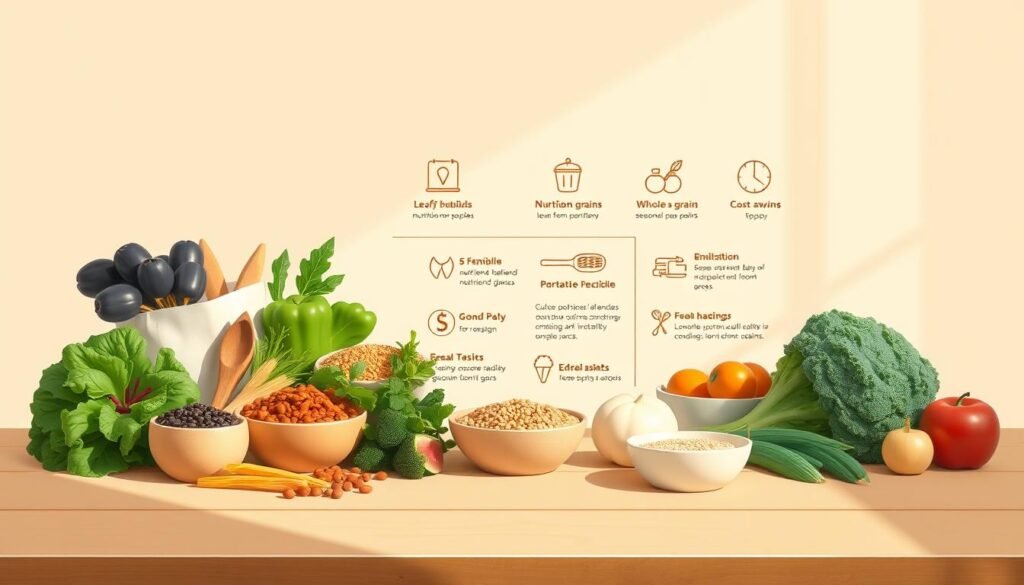Can you eat healthy without spending a lot? Many think it’s hard to eat well on a budget. But, there’s a way to do it without breaking the bank.
Healthy eating doesn’t need to be expensive. You don’t need fancy ingredients or hard meal plans. With smart budget-friendly recipes, you can make tasty, healthy meals that fit your budget.
It’s all about making smart choices. Learning to pick affordable healthy meals and plan meals wisely can help. This way, you can take care of your health without worrying about money.
Key Takeaways
- Healthy eating can be affordable with the right strategies
- Meal planning is crucial for budget-conscious nutrition
- Affordable ingredients can create delicious, nutritious meals
- Smart grocery shopping saves money and supports health
- Cooking at home is more cost-effective than eating out
Understanding the Basics of Budget-Friendly Nutrition
It’s easy to eat well without spending a lot. Cost-effective nutrition means choosing wisely to save money and stay healthy. With the right strategies, you can make tasty, healthy meals without overspending.

Essential Nutrients on a Limited Budget
For cheap meal prep, focus on key nutrients. Your body needs proteins, carbs, and vitamins to be healthy. Here are the top nutrients to focus on:
- Protein: Eggs, beans, lentils, canned fish
- Complex carbohydrates: Brown rice, oats, whole wheat bread
- Vitamins: Frozen vegetables, seasonal produce
- Minerals: Fortified foods, affordable leafy greens
Debunking Nutrition Cost Myths
Many think nutritious budget meals are impossible. But, with smart shopping, you can eat well without spending a lot. It’s all about finding the right deals.
| Nutrient | Budget-Friendly Sources | Average Cost |
|---|---|---|
| Protein | Beans, Eggs, Canned Tuna | $0.50-$2 per serving |
| Carbohydrates | Brown Rice, Oats, Potatoes | $0.25-$1 per serving |
| Vegetables | Frozen Mixed Vegetables | $1-$2 per bag |
Creating a Balanced Plate Economically
When planning meals, aim for half veggies, a quarter protein, and a quarter carbs. This balance is key to staying healthy and saving money.
“Eating healthy on a budget is about creativity and smart planning, not expensive ingredients.”
Smart Grocery Shopping Strategies for Maximum Savings

Learning to shop smart for groceries can change how you eat without spending a lot. You don’t have to pay a lot for healthy food if you use the right tips.
Start by planning your shopping carefully. Make a list of cheap, healthy meals and the ingredients you need. This stops you from buying things you don’t need and keeps your spending in check.
- Plan your meals in advance
- Compare prices across different stores
- Use store loyalty programs
- Buy seasonal produce
- Choose store brands over name brands
Buying in bulk can save you a lot on healthy meals. Look for deals on items like rice, beans, and frozen veggies. Smart shoppers know that buying more means saving more.
Using digital tools can also help you save money. Apps, cashback programs, and websites that compare prices can cut down your food costs. This way, you can still eat well without spending too much.
“The key to budget-friendly nutrition is strategic shopping, not sacrificing quality.” – Nutrition Experts
When you shop, timing is everything. Buy during sales, use coupons, and pick slightly imperfect fruits and veggies. They’re cheaper but still full of nutrients.
Healthy Eating on a Budget: Delicious & Nutritious Meal Ideas
Creating nutritious meals on a budget doesn’t mean giving up taste or health. It’s about choosing the right ingredients and cooking smart. This guide will show you how to eat clean without spending a lot.
To cook healthy on a budget, focus on getting the most nutrition for your money. Pick ingredients that can be used in many different meals. This way, you can save money and still eat well.
Breakfast Options Under $2 Per Serving
There are many affordable breakfasts that are both tasty and healthy. Here are some ideas:
- Overnight oats with frozen berries
- Egg and vegetable frittata
- Banana and peanut butter toast
- Greek yogurt parfait with granola
Budget-Friendly Lunch Solutions
Lunches can be both affordable and nutritious. Here are some options:
- Bean and rice burrito bowls
- Chickpea salad sandwiches
- Lentil soup with whole grain bread
- Tuna and vegetable wraps
Affordable Dinner Recipes
Dinner doesn’t have to be pricey to be tasty. Here are some budget-friendly dinner ideas:
- One-pot chicken and vegetable rice
- Black bean and sweet potato chili
- Vegetable stir-fry with brown rice
- Pasta primavera with seasonal vegetables
Pro tip: Buy ingredients in bulk, use seasonal produce, and plan your meals to maximize savings without compromising nutrition.
Seasonal Shopping: Maximizing Nutrition and Minimizing Costs
Seasonal shopping is a smart way to make affordable meals and stay healthy. It lets you find nutritious food that’s also good for your wallet.
Smart shoppers know the benefits of seasonal produce:
- Lower prices because there’s more of it
- Higher nutritional value when it’s in season
- Better taste than out-of-season options
- Less cost and environmental impact from transport
Knowing which produce is in season is key for saving money. Summer has lots of berries, tomatoes, and zucchini. Winter is great for root veggies like sweet potatoes and squash.
To shop seasonally, follow these steps:
- Find out when things grow in your area
- Go to farmers markets for fresh, local food
- Learn how to freeze and can food
- Plan meals with what’s in season
Choosing seasonal ingredients helps you eat well without spending too much. It makes grocery shopping a fun, strategic part of your life.
Meal Prep Fundamentals for Cost-Effective Eating
Learning to meal prep is a big win for those watching their budget. It makes cooking healthy meals cheaper and saves time and money. When you know the basics of meal planning, making affordable meals is simpler.
To turn your kitchen into a place for affordable meals, learn some key strategies. These make planning meals on a budget fun and easy.
Essential Meal Prep Equipment
Getting the right tools can change how you cook on a budget. Here are the must-haves:
- Sturdy meal prep containers with secure lids
- Quality chef’s knife for efficient chopping
- Large cutting board
- Slow cooker or instant pot
- Food storage bags
Storage Solutions for Extended Freshness
Storing food right keeps your meals fresh longer, saving you money. Airtight containers and smart fridge use are key to keeping food good.
| Storage Method | Food Type | Recommended Storage Time |
|---|---|---|
| Refrigeration | Cooked Proteins | 3-4 Days |
| Freezing | Prepared Meals | 2-3 Months |
| Vacuum Sealing | Raw Vegetables | 1-2 Weeks |
Time-Saving Prep Techniques
Efficient meal prep changes how you cook. Pick recipes that use the same ingredients, cook proteins in bulk, and prep veggies early. These tips help you make healthy meals quickly and affordably all week.
- Cook large batches of grains and proteins
- Chop vegetables in advance
- Use marinades to add variety
- Plan meals around seasonal ingredients
Pantry Staples That Stretch Your Dollar
Starting to make nutritious meals on a budget begins with a well-stocked pantry. Affordable healthy cooking uses versatile staples that offer balanced nutrition without spending too much. Planning your pantry well can change how you cook affordably and save money while keeping your diet great.
Key pantry items for frugal meal prep include:
- Dried Beans: An affordable protein source with a long shelf life
- Rice: A versatile grain that’s a base for many dishes
- Canned Tomatoes: A nutritious ingredient for sauces and stews
- Oats: A multipurpose ingredient for breakfast and baking
- Frozen Vegetables: A nutrient-dense and affordable alternative to fresh produce
Smart shoppers buy these staples in bulk to cut down on grocery costs. Look for sales, compare prices, and choose store-brand options to stretch your budget. Keeping these items stored properly ensures they stay fresh for your next meal.
Pro Tip: Rotate your pantry stock and check expiration dates to minimize waste and maintain a fresh, budget-friendly ingredient collection.
Investing in these affordable pantry staples lets you make diverse, nutritious meals that support your health goals without overspending. The secret is to be strategic, creative, and mindful of your food choices.
Plant-Based Protein Sources for Budget-Conscious Eating
Eating well on a budget doesn’t mean you have to skip protein. Plant-based proteins are a cost-effective way to prepare meals. They can change how you shop for groceries and keep you and your wallet happy.
Looking into plant-based proteins can cut down your food costs. It also keeps your diet nutritious. Frugal foodie hacks show you can get great protein without spending a lot.
Legumes and Pulses: Nutritional Powerhouses
Legumes and pulses are great for saving money on food. They are full of protein and offer great value:
- Lentils: Just $1 per pound, providing 18 grams of protein
- Black beans: Approximately $1.50 per can, with 15 grams of protein
- Chickpeas: Around $1 per can, delivering 14 grams of protein
Affordable Meat Alternatives
For a protein-rich diet, try these affordable meat alternatives:
- Tofu: Typically $2-$3 per block, offering 10-15 grams of protein
- Tempeh: About $3-$4 per block, with 20 grams of protein
- Seitan: Roughly $3-$4 per package, providing an impressive 25 grams of protein
Adding these plant-based proteins to your meals can make them tasty and healthy. It also helps you cook smartly on a budget.
Money-Saving Cooking Methods and Techniques
Learning to cook on a budget can change how you plan meals. Frugal eating starts in the kitchen. Here, smart cooking methods help make healthy meals without spending a lot.
Batch cooking is a big help for saving money on food. It lets you cook a lot of food at once. This way, you can:
- Save time in the kitchen
- Use less energy
- Make different meals from the same ingredients
- Buy less food on impulse
Using versatile appliances makes meal prep easier. Slow cookers and pressure cookers turn cheap ingredients into tasty meals. They use less energy and make tough cuts of meat tender.
Smart cooking techniques can also save money. Try these tips:
- Use herbs and spices to make simple foods taste better
- Add affordable proteins like beans and lentils
- Roast veggies to bring out their sweetness
- Try one-pot meals to save on cleanup and energy
With these cooking methods, families can eat well and stay within their food budget.
Reducing Food Waste to Maximize Your Budget
Reducing food waste is key to making cheap and healthy meals. In the U.S., people throw away 30-40% of their food. This is a big financial loss and a missed chance for affordable meals.
Smart food storage changes how you make nutritious meals on a budget. Using the right preservation methods keeps ingredients fresh longer. This way, you can make the most of your money.
Smart Storage Tips for Extended Shelf Life
- Store herbs in water like fresh flowers to keep them crisp
- Use airtight containers for grains and dry goods
- Freeze leftovers in portion-sized containers
- Use vacuum-sealed bags for meat and produce
Creative Leftover Transformations
Turning leftovers into new dishes is a great way to save money. Here are some creative ideas:
- Turn roasted chicken into chicken salad
- Transform vegetable scraps into homemade stock
- Use stale bread for croutons or breadcrumbs
- Blend overripe fruits into smoothies
“Waste less, spend less, eat better” – Food Sustainability Experts
| Food Type | Storage Method | Estimated Extended Shelf Life |
|---|---|---|
| Fresh Vegetables | Refrigerate in perforated bags | 5-7 days longer |
| Cooked Meats | Vacuum seal and freeze | 3-4 months |
| Bread | Freeze in airtight container | 2-3 months |
By using these budget-friendly tips, you can cut down on food waste. This helps you save money and still eat well.
Building a Weekly Meal Plan on a Budget
Creating a budget-friendly meal plan can change how you eat and manage money. Start with smart weekly planning. This way, you use affordable foods and still get all the nutrients you need.
To plan meals on a budget, follow these steps:
- Check what you already have in your pantry to avoid buying too much
- Look at weekly sales and ads for grocery stores
- Choose meals with seasonal and cheap ingredients
- Use versatile foods like beans and eggs
- Cook big batches of ingredients for many meals
Pro tip: Flexible meal planning lets you change recipes based on what’s in season and prices.
“Planning is bringing the future into the present so you can do something about it now.” – Alan Lakein
Your meal plan should aim for variety and nutrition without spending too much. Focus on ingredients that can be used in many dishes. This cuts down on waste and saves money.
Think about using a meal template that includes:
- One-pot meals
- Slow cooker recipes
- Batch-prepared proteins
- Versatile grain bases
- Mix-and-match vegetable sides
With these tips, you’ll get better at making meals that are both affordable and healthy.
Tips for Eating Healthy While Dining Out on a Budget
Finding healthy meals at restaurants can be tough. But, you don’t have to skip dining out to save money. With the right strategies, you can enjoy meals out without breaking the bank or your health goals.
Here are some tips for finding cheap healthy meals at restaurants:
- Split larger portion meals with a dining companion
- Choose lunch specials which are typically less expensive
- Request dressings and sauces on the side
- Drink water instead of expensive beverages
Looking for budget-friendly meals isn’t just for home cooking. Many restaurants have healthy options at good prices. Opt for grilled proteins, vegetable dishes, and smaller portions to save on calories and money.
Ordering wisely can make dining out affordable and healthy. Check restaurant websites for nutrition and prices before you go. Many places list their menus online, helping you pick budget-friendly options.
Smart diners understand that budget-conscious nutrition is about making informed choices, not total restriction.
Here are more ways to save money at restaurants:
- Use restaurant loyalty programs
- Check for early bird or happy hour specials
- Limit dining out to once or twice weekly
- Share appetizers or desserts
With a little planning, you can enjoy tasty meals out while keeping your budget and health goals in check.
Conclusion
Getting a balanced diet doesn’t mean you have to spend a lot of money. This guide shows you can eat well without breaking the bank. By planning smart and getting creative, you can afford to eat healthy.
Creating tasty and healthy meals doesn’t have to be expensive or time-consuming. Use pantry staples, plant-based proteins, and smart shopping to save money. It’s all about finding a balance between eating well and being frugal.
Start making small changes to eat better on a budget. Cut down on food waste and learn to cook affordably. Every step you take gets you closer to eating healthy without spending a lot.
Healthy eating on a budget is about making smart choices. It’s about feeding your body and saving money at the same time. With the right tips, you can make meals that are both delicious and budget-friendly.





